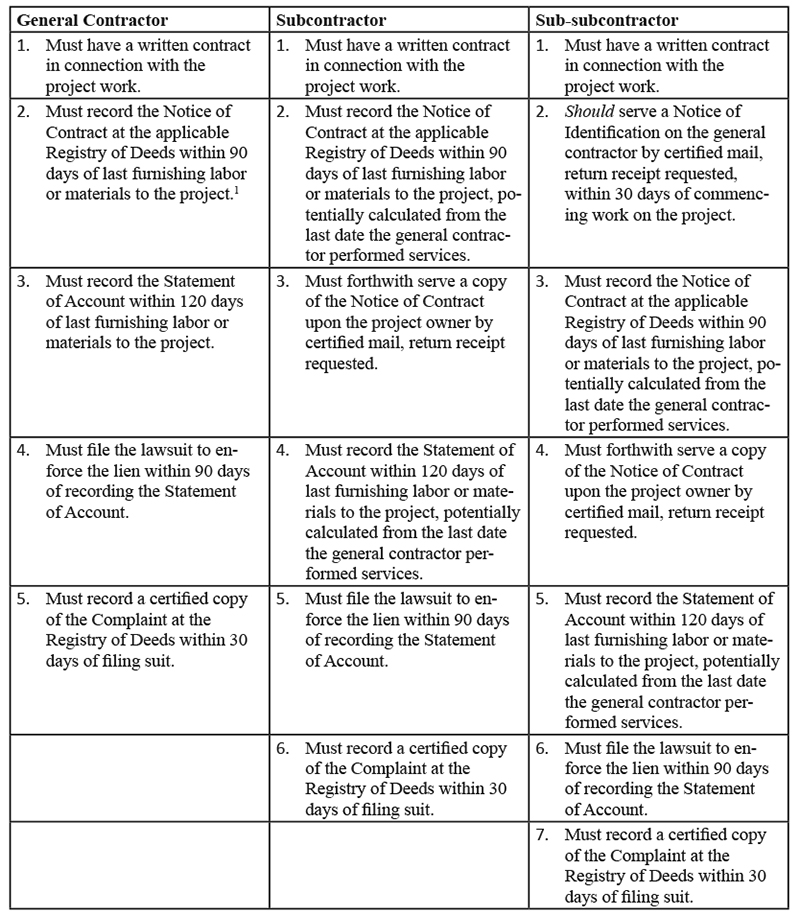Second in a series of articles about how to avoid construction litigation
 Adam Ponte, Fletcher Tilton PC Attorneys at Law
Adam Ponte, Fletcher Tilton PC Attorneys at LawWhat You Need To Know About Massachusetts Mechanic’s Liens Many of us in the construction industry generally understand what it means to “lien a project”. But do we really know all of the requirements that must be satisfied to properly record a mechanic’s lien against a project property? Understanding these rules could help a general contractor get fully paid on a job; or could help a project owner fully defend against a defective lien. If you are a contractor, subcontractor, project owner, or are otherwise involved in real estate development and construction, you need to know the rules surrounding the mechanic’s lien law, M.G.L. c. 254.
I. Mechanic’s Liens Generally. Controlled by statute, a mechanic’s lien, once properly recorded and perfected, essentially operates as if it were a mortgage on the subject property. Mechanic’s liens may be asserted only on private construction projects. They are unavailable on public construction jobs. Any general contractor, subcontractor, sub-subcontractor or supplier that has furnished labor or materials to a private construction project can potentially record a mechanic’s lien. The party asserting the lien must have a written contract in connection with the labor and/or materials furnished to the project. The monetary amount of the lien on the property may only be for the amount due on the date that the lien is recorded. Accordingly, if the total contract price was $1,000,000 of which $800,000 had been paid to the contractor (including change orders), the enforceable lien amount would be $200,000.
To initiate a mechanic’s lien, a general contractor, subcontractor or supplier must record a Notice of Contract with the applicable Registry of Deeds. The where, when and how in connection with recording this Notice of Contract are crucial. Subsequent to this recording, the party asserting the lien must follow specific steps to perfect the lien, so that it is enforceable in any proceeding, including formal litigation. See M.G.L. c. 254, §§ 2, 4.
If you are a sub-subcontractor (an entity that does not have a contract with an entity directly contracted with the owner) you must serve a Notice of Identification on the project general contractor within thirty (30) days of starting work on the project. This notice must be served by certified mail, return receipt requested, and, if this notice is not timely served, the sub-subcontractor receives no mechanic’s lien protection until after the Notice of Contract is recorded. See M.G.L. c. 254, § 4.
II. The Process: Timing Is Everything. General contractors seeking a mechanic’s lien must follow the process outlined under M.G.L. c. 254, § 2. Subcontractors or suppliers and sub-subcontractors who lack direct contracts with the general contractor must follow the process outlined under M.G.L. c. 254, § 4.
It is imperative that any general contractor, subcontractor, sub-subcontractor or supplier seeking payment satisfy the timing requirements under the mechanic’s lien law. The following chart has been provided to identify the critical requirements and deadlines for perfecting a mechanic’s lien:
III. Conclusion After perfecting the mechanic’s lien, the contractor or supplier’s ultimate goal – of course – is to get paid. The existence of a properly asserted lien could compel settlement. Otherwise, if the contractor or supplier must proceed to litigation in superior or district court, to pursue payment, it must ultimately establish that it: (1) satisfied all of the filing and recording requirements under the mechanic’s lien law; and (2) indeed is due monies from the owner for labor or supplies furnished to the project. The owner must investigate these claims and confirm that the contractor or supplier actually perfected its mechanic’s lien rights.
If you are a project owner, contractor or supplier, and there are any payment issues on your private construction project, you should consult with a construction lawyer to fully understand the mechanic’s lien process and evaluate the potential for problems down the road.
(Footnotes) 1 The deadline to record the Notice of Contract or Statement of Account (for general contractors, subcontractors or sub-subcontractors), could be accelerated if a Notice of Substantial Completion or Notice of Termination is recorded. For example, if a Notice of Substantial Completion is recorded, the Notice of Contract must be recorded within 60 days of the substantial completion recording.
Adam Ponte, Esq. is a litigation attorney at Fletcher Tilton PC Attorneys at Law, Worcester, Mass.
 (1).jpg)








.png)